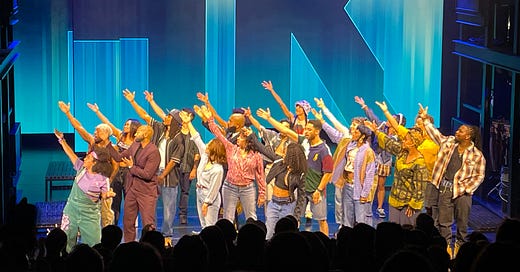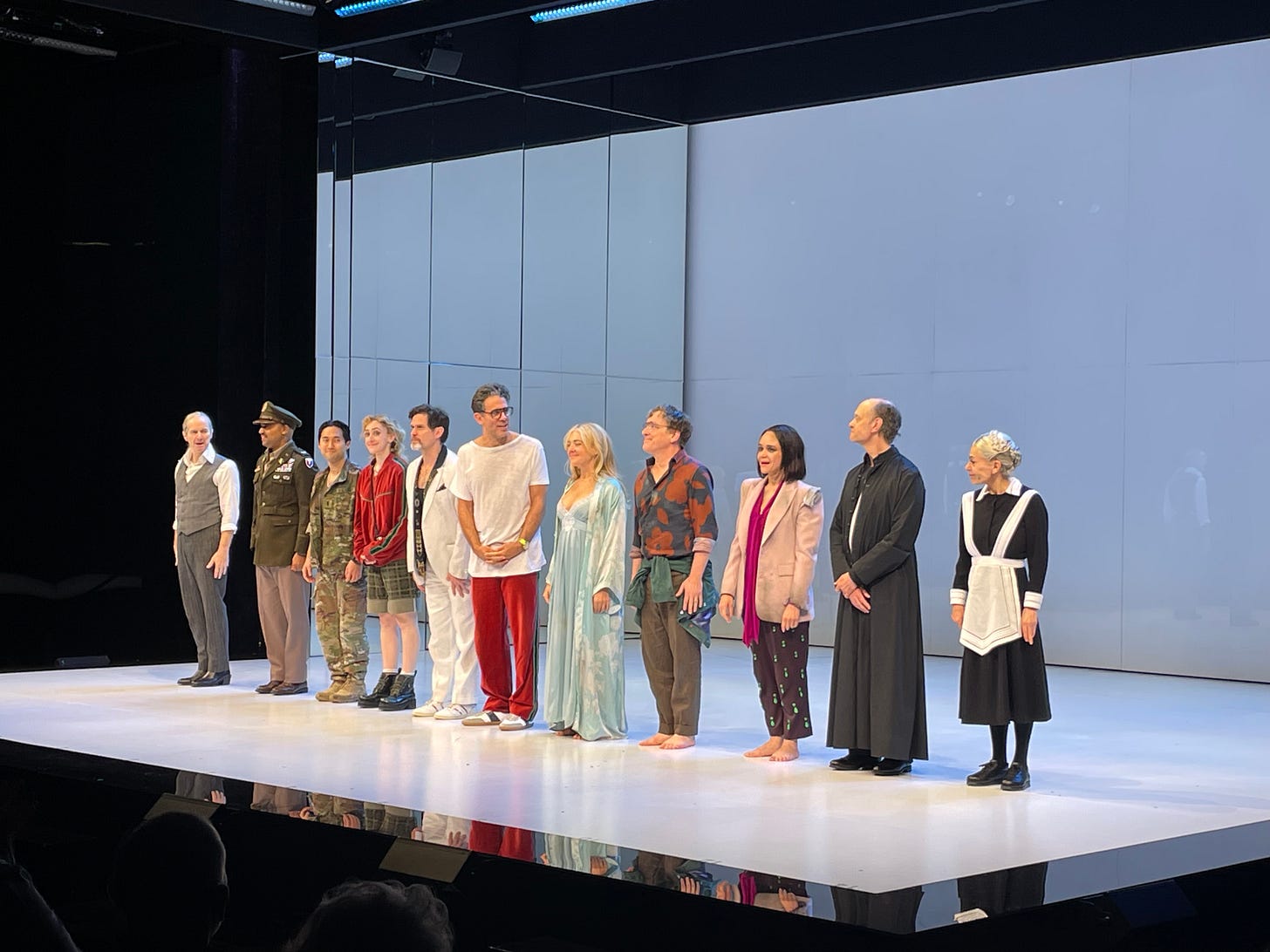Alicia Keys's music set to explosive dance in "Hell's Kitchen", plus the final Sondheim musical, "Here We Are"
My reviews of two new off-Broadway productions playing now in New York
Hello, play-goers! I’m just back from New York, where I enjoyed two action-packed days seeing four terrific plays. Here are my reviews of the two I saw off-Broadway. I’ll follow up next week with the other two! Have you seen these? Send me your thoughts!
Hell’s Kitchen
If you’re looking for a high-energy, dance-forward show, “Hell’s Kitchen” is the one. This passion project of Alicia Keys, whose early biography is the basis of the plot and whose music tells the story, is brought to vivid life by the acclaimed director Michael Greif and, in particular, the choreography of Camille A. Brown.
The story concerns Ali, a 17-year old biracial girl living in Hell’s Kitchen in the early 90s keen to explore the world beyond the artist-housing apartment building where she lives with her mom. Ali is played by an absolutely fantastic Maleah Joi Moon, making a powerful professional debut. Through direct-to-audience narration (which worked well, putting us squarely inside her perspective), she effectively guided us through her story, which focuses on four key relationships: with her single-parent, protective white mother (a radiant Shoshana Bean); a love interest named Knuck; her unreliable, artist father; and, most compelling in my view, her piano teacher (Kecia Lewis, who gives a show-stopping performance). Against the warnings of her mother, she pursues Knuck, and the main conflict erupts when Ali’s mother calls the police after finding the lovers together in her apartment. Knuck’s run-in with the police leads to the most profound moment of the show, when her piano teacher sings the protest song “Perfect Way to Die,” in a gorgeous, deep alto.
Alicia Keys’s music is fantastic in the show. Keys was not precious about presenting her songs as we’ve always heard them; the arrangements seemed designed around advancing characters, not giving fans the music they love exactly as they’ve heard it before. (She also wrote several new songs for the show.) Songs were interrupted, spliced together, used as underscoring, etc—all of which put them in service of the story (and not the other way around, as in many jukebox musicals). Tunes we’ve always understood as romantic love songs were repurposed as mother-daughter duets, to great effect.
After the music, the choreography is the strongest aspect of the production. The early-90s setting drove the dance vocabulary, which was predominantly a “street”/hip-hop style. The movement told the story, versus being superfluous and merely entertaining. The dancers did not sing, an unconventional choice for a musical. Instead, as principal characters sang to each other, dancers would come out to give additional expression to the principals’ emotions and desires. This choice worked so well—it allowed the characters to stay still and focus on each other, to the soulful R&B of Keys’s brilliant music, while the audience still experienced the depth of their feelings through the dancers’ movement. For example, when the protagonist’s love interest, a Black man, was singing about the difficulty of existing in a white world, he stayed still, conveying a defeatism. But a male dancer appeared to convey, through movement, how desperately he wants to break out of those limits. This pairing brought out the complexity and depth of his feelings.
The flaws in the production are largely in the book, by Kristoffer Diaz. Though it is mostly very strong, at a few moments in the second act, the plot jumped the shark. For example, after an entire act of warning Ali away from Knick, her mother feels so bad about calling the police on him that she tells Ali to go talk to him again. What?! In the next scene, she goes to tell off Ali’s father for failing to do more to help their daughter. It’s just a set-up for the song “Pawn it All,” and while it strained credulity, moments later I found myself swept up in the power of the song and the performance.
These flaws are pretty easily cleaned up with some tweaks to the book, and maybe some song substitutions. And with a world premiere like this, it’s fun to imagine what might change in a subsequent production. My vote is the following: more focus on the music teacher, who is the most mysterious and compelling of the secondary characters. While the mother and father are largely archetypes—mother over-protective; father absent—the music teacher is severe, intense, committed to training Ali both given her inherent talent and as a project of racial uplift: she encourages Ali to connect to all the Black women pianists who came before her, and to play even when rage at racial injustice consumes her. This relationship could be deepened with more back-story on the teacher: for example, does she have a particular, personal connection to police brutality that motivates her powerful Act 1 closing song?
This show is almost certainly heading to Broadway and I so look forward to seeing how it develops!
Playing through January 14 at the Public Theater
Here We Are
I tell you: the man cannot write a bad song! Attending “Here We Are,” the final musical Stephen Sondheim was working on at the time of his death two years ago, the giddiness I felt as the orchestra started on the first notes was unparalleled. I’ve never seen one of his works where I didn’t already know every note and lyric from listening to the cast album many times! So to be totally surprised was a thrill—and my excitement was met with some beautiful music plus funny and contemporary lyrics. It was distinctly Sondheim, though didn’t sound to my ears like anything he’s done before. That was always his gift—constant reinvention, creating compositions that suited the material.
Besides the music, the other delight of this show was the ever-surprising turns it took, at least in the first half. Based on the surrealist films of Luis Buñuel and with a book by the playwright David Ives, the first act concerns a group of privileged bourgeoise people trying to find a restaurant for brunch, but being thwarted at every turn for strange reasons. They finally find a place to eat, but in the second act, they cannot leave the room, also for unexplained reasons. Throughout, the sounds of a revolution to overthrow the whole capitalist/bourgeoise system may be proceeding outside. Strange, indeed!
The surrealism was funny in the first part but got much darker in the second, which also featured fewer songs to lift up the proceedings. Many ideas and relationships were set up in the first half, each twist providing new intrigue to the audience; while exciting as they emerged, these were not all satisfactorily developed and resolved in the second. Even so, it was still gratifying to see the characters eventually figure out how to leave the room. At the end, they recounted how they had changed from all that time spent stuck—and I got chills. So the overall effect was powerful, but there is some trimming and editing needed in the middle of the second act to help tighten up the drama. I also predict I’ll appreciate this more as I reflect on it—it’s definitely a “think it over afterwards” kind of play.
Joe Mantello’s direction helped bring out the absurdity and manage a complex set-up, in which most characters were on stage the whole time. He and Ives managed to create intimate moments among a few of them through careful blocking. The cast was a “who’s who” of some of Broadway’s finest performers today—and they were across the board excellent. Another key to the show’s success was David Zinn’s set design: an all-white, box-like frame, with simple pieces that flew in to show each restaurant, until the characters finally found a place to eat, and then an entirely new, richly decorated set slid in from backstage with a dramatic flourish.
This is a must-see because of the Sondheim score and terrific performances. But it isn’t a great musical yet—that will take some more refining.
Playing through January 21 at The Shed
Stay tuned for my reviews of “How to Dance in Ohio” and “Purlie Victorious” next week!






